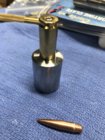jelenko
Gold $$ Contributor
If the Hornady modified case headspaces to, say, 0 and the brass you are loading with is headspaced to 0, then the distance to the lands from the ogive would be the same - yes?Are you attempting to find distance to lands, or are you measuring chamber length, aka headspace? You need to know your chamber length prior to establishing your distance to lands.
Except in belted cartridge cases, bottle neck cartridges index off the shoulder. So it is the distance from the shoulder to the lands that you are establishing, although we tend to measure by referencing off the case base. Now imagine using a cartridge case that is one inch shorter than the chamber, and how that would effect your measurements.
Regardless of the cartridge case you choose, you'll need to account for any difference between the base to datum length as compared to the actual chamber dimensions.
For instance, say you use a Hornaday LNL modified case that is .008 shorter than a case you've shot that is fully fire formed and chambers with a slightly stiff bolt drop. IOW, it fits the chamber precisely. Using the Hornady case to find and measure CBTO will yield a .008 error in the distance to the lands as compared to using a fully fire formed case.
Continuing on, whether you prefer to hand load using cases that are fully fire formed and fit the chamber snugly, or bump shoulder back for ease of chambering, you'll need to account for the difference when seating bullets IF your chosen bullet is sensitive regarding seating relative to the lands. In a worst case scenario, seating to touch during load development would yield very inconsistent results in SD/ES and target groups due to these variances in how the case was sized, how CBTO was measured, and consistency in bullet seating.
Thanks











